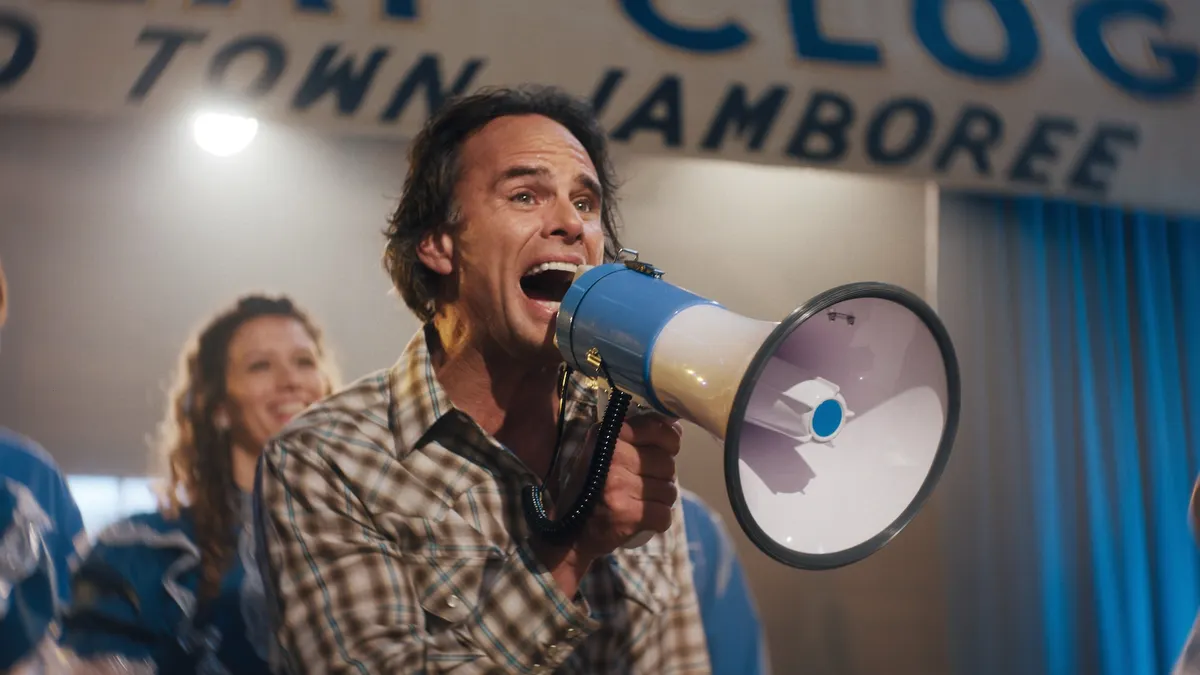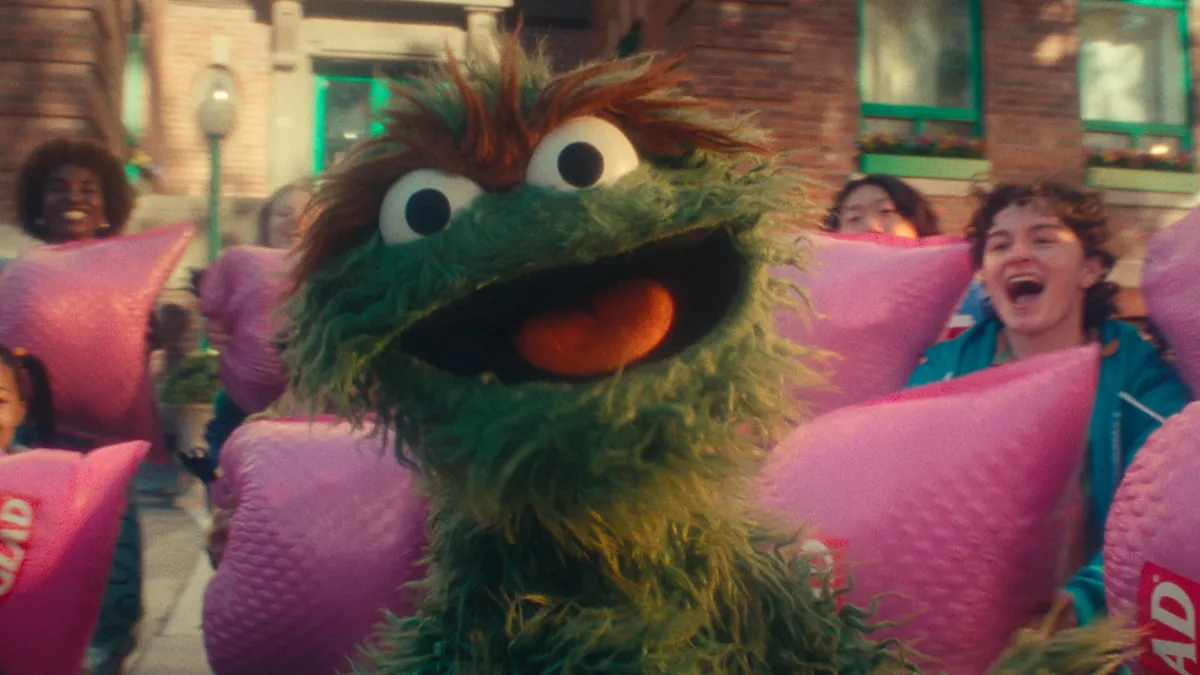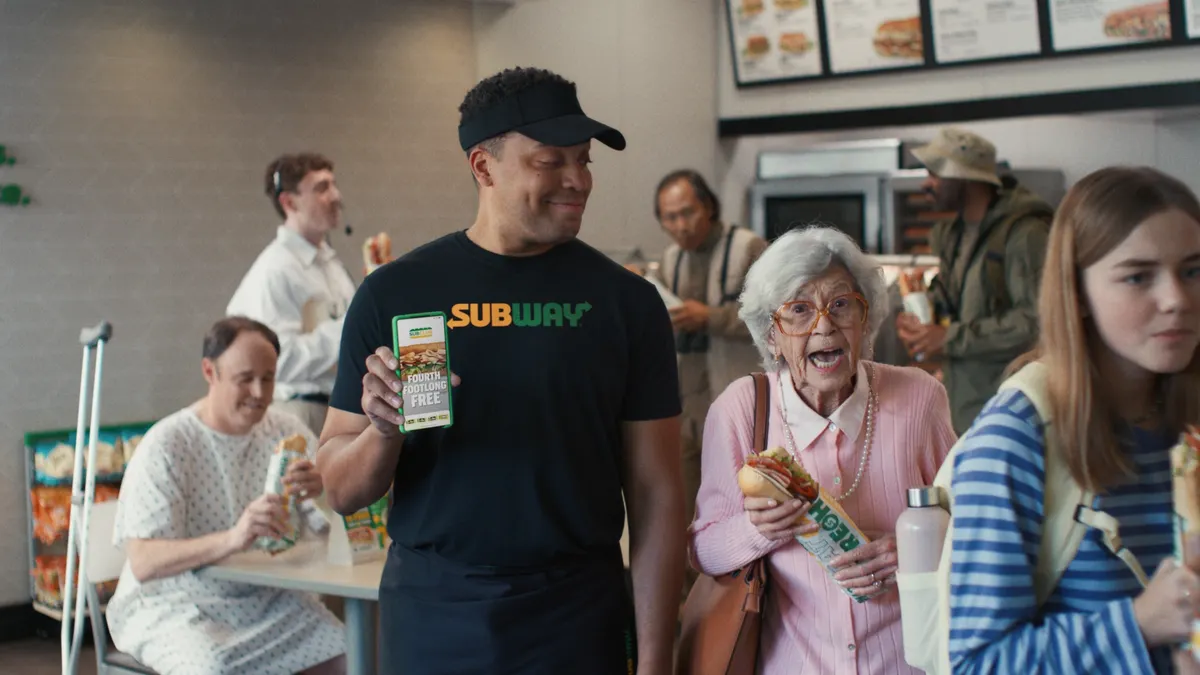At the top of the year, we predicted that the growth of social commerce, the evolution of influencer marketing and changes to the augmented reality (AR) landscape would be some of the trends that shaped mobile marketing this year.
By that measure, we got it right, thanks to developments like the debut of Instagram's native checkout, Burger King's "ad-burning" in AR or Sony's use of influencers on TikTok. But mobile marketers also continued to innovate and surprise this year, dropping scannable music videos and packaging, hijacking loyalty and social media, and even doubling down on SMS.
Whether or not we called it, here are nine of the year's best mobile campaigns.
Burger King merges AR and OOH to set rivals' ads aflame
In a savvy move to merge out-of-home (OOH) with mobile AR, Burger King let app users in Brazil unlock a free Whopper by virtually setting fire to rivals' ads. The chain's app in March showed a "Burn That Ad" banner that people could tap while pointing their smartphone camera at a print or billboard ad from competitors like McDonald's, igniting a virtual flame that blazed away to reveal a coupon.
The campaign by agency David Sao Paulo aimed to highlight BK Express' pre-ordering, payment and pickup capabilities, along with engaging mobile users and driving foot traffic to store locations.
Though the campaign's teaser video never mentions McDonald's by name, pixelated imagery suggested that Burger King's effort directly targeted the rival. The move came as brands — especially fast-food chains — have incorporated more direct jabs at competitors as they seek creative ways to win customers and online conversation.
Burger King's mobile-based "troll campaign" demonstrates how brands can capitalize on this trend of off-the-cuff banter to build a stronger social media presence and flex some marketing muscle with OOH with AR.
Expensify collabs with 2 Chainz on a scannable music video
Expensify's first Super Bowl ad scored several touchdowns. While its product — an expense management app — isn't inherently cool, the company's "You Weren't Born to Do Expenses" campaign was, thanks to a pitch-perfect music video featuring rapper 2 Chainz and actor Adam Scott. Notably, the video showed off the app's abilities by being scannable, adding a mobile element to an already internet-friendly video.
The fact that some of the video's gaudy objects — an ice-sculpted sports car and a gold bust of 2 Chainz — could be conspicuously consumed by scanning the video with the Expensify app likely helped the company drive app downloads and get users to try its product. Creative agency JohnXHannes New York and audio agency Barking Owl collaborated on the campaign, which was one of the best during a generally risk-averse Super Bowl season.
The over-the-top video was true to 2 Chainz's artistry as well, scoring more than 12.5 million views on YouTube and a 96% positive sentiment rating — the highest of all the Super Bowl advertisers this year, according to 4C data cited by Marketing Land.
"That one works great, because he's kind of making fun of it all a little bit," Barking Owl's creative director and partner Kelly Bayett told our sister publication Marketing Dive. "It's very true to who he is as an artist, and I think that it's the only way that something like that works."
Domino's slices the competition with rewards for all pizza — not just its own
Domino's earlier this year baked up a standout example of how to use mobile to drive excitement around the Super Bowl, all without having to invest in an expensive TV ad. The Super Bowl remains one of the most-watched live events of the year and biggest days for pizza sales. Knowing this — and with competitor Pizza Hut as the official pizza sponsor of the NFL — Domino's leveraged internally developed artificial intelligence (AI) software for a promotion that rewarded points for any pizza scanned, even those served by competitors.
All people had to do was download the Domino's app, register for its Piece of the Pie Rewards program and scan images of pizza to earn points. The result was a clever promotion that disrupted Domino's competition by giving customers a reason to download the Domino's loyalty app and start collecting rewards.
While the spirit of the effort was born out of the "hackvertising" trend that's been especially apparent in the fast food vertical, it was mobile and image-recognition technology that brought the idea to life.
Warner Bros. unveiled Snapchat's first voice-activated AR lens with 'Shazam!'
To promote "Shazam!" — 2019's lone entry in the DC Extended Universe — Warner Bros. teamed with Snapchat for the social platform's first voice-activated AR lens. Snapchat users who said, "OK, Shazam!" after opening the lens would be transformed into the superhero faster than they could say "Solomon, Hercules, Atlas, Zeus, Achilles and Mercury" — the mythological figures that give Shazam his name.
The voice activation mimicked how teenager Billy Batson transformed into the mighty Shazam in the movie, giving Snapchat users an even more engaging experience than standard-issue AR lenses. Beyond the playful integration, the lens could also be unlocked by scanning Snapcodes on billboards, murals and posters, giving the campaign an OOH angle.
While AR lenses have been used by other studios to promote films, the "Shazam!" offering seemed like an effective way to attract the teens and young adults that Warner Bros. thought might see the movie. U.S. Snapchat users visit theaters at least once a month on average, and Snapchat users represent 36% of all moviegoers and 50% of all movie ticket sales in the country, according to a study from NRG Research Group commissioned by Snap last year.
For Snapchat, the addition of voice-activated AR gives marketers another tool on the platform, which has spent most of the year working to attract more brand dollars. Shortly after the "Shazam!" campaign, Snapchat held its first partner summit, unveiling syndication of Stories, an audience ad network, a gaming platform, mobile-first shows and more.
Marketers can't 'escape' TikTok's power
Sony's campaign for the movie "Escape Room" immersed popular influencers in real-life challenges that they could share on TikTok, exemplifying the relatively untapped power of Gen Z marketing on the video-sharing platform.
After first boosting the thriller with 360-degree video playable ads, Sony Promotions hired 30 influencers for a Madrid event in partnership with TikTok, where the creators escaped real rooms designed similarly to scenes in the movie. The users filmed over 75 short clips of themselves solving the challenges to share with their followers.
Apart from a Sony Productions video, most of the content was shared on an official "Escape Room" movie page on the TikTok app and through the influencers. TikTok is proving to be an increasingly valuable resource to meet otherwise elusive young audiences: As of May, the app had an estimated 1.2 billion downloads.
Brands like Chipotle and Marc Anthony have found success with the app's following, boosting engagement and sales. Meanwhile, Uniqlo recently launched TikTok's first multimarket brand campaign with a video challenge contest.
But TikTok, owned by Chinese company ByteDance, has only recently emerged as a viable marketing tool. Despite brand safety concerns, the platform's first appearance at the Cannes Lions International Festival of Creativity this year and steady position among the top five apps in the Apple and Google Play app stores suggests it's here to stay. Sony's campaign is a standout example of how advertisers can start to capitalize on the platform.
Chipotle rolls Twitter, SMS and basketball into burrito promotion
Fast food chains are embracing mobile, with many rolling out rewards apps and delivery partnerships. For its part, Chipotle this spring unwrapped a compelling way to engage consumers through a combination of mobile technology, must-watch programming and an appealing offer to drive engagement and sales — both in-store and online — while building its opted-in SMS list. Toward the end of the NBA season, Chipotle shared codes on Twitter that were good for a free burrito every time an announcer said "free" on-air during official league game coverage.
While the "Freeting" campaign gave hungry basketball fans a reason to engage with Chipotle online, the chain extended the mobile push by requiring viewers to text a code to a promotion-specific short number in order to get one of the $1 million worth of burritos being dished out.
Chipotle's contest stands out because it was crafted to engage the NBA's significant Twitter following rather than take attention away from the game, a common mistake by brands. For example, Volvo tied a mobile-based contest to the Super Bowl with a game that challenged viewers to keep their eye on a video of a car for as long as possible for a chance to win a subscription for a car, thereby luring fans away from the action.
Coke taps nostalgia with massive interactive smartphone campaign
Coca-Cola's campaign for summer 2019 goes mobile in a big way: "Sip and Scan" lets customers use their smartphones to tap Coke drinks and score prizes. The push puts a brief pause on the soft drink maker's popular "Share A Coke" messaging, swapping in "Enjoy" labels on packaging and marking the first time a word other than the brand's name has appeared in its signature Spencerian font, according to Ad Age. And while other alcohol marketers like Miller Lite and Angry Orchard have also introduced mobile-ready beverages this year, Coke is linking together scannable products with interest around timely experiences, such as the FIFA Women's World Cup.
Coke's first summer marketing switch-up in six years doles out more than 150,000 prizes, which range from concert tickets to meeting members of the U.S. Women's National Team after the World Cup. To activate the chance to win, users peel away sticker wristbands from the can or bottle to reveal a logo — the more logos scanned, the higher the chance for a prize.
The summer packaging first hit shelves in May, but Coke has seen success with similar interactive product marketing before. In Romania two years ago, the brand introduced wristbands that doubled as music festival entrance passes. However, "Enjoy Coca-Cola" is the first time the most popular soft drink brand will engage smartphone users in this way on a nationwide scale. As Americans are drinking less soda, the packaging play focused on entertainment and experiences helps to invoke a sense of patriotism and tradition of the season.
Cars.com shifts focus of live Super Bowl commentary to the ads
Cars.com opted to forego an expensive Super Bowl ad this year in favor of commenting on other brands' ads in real time on Twitter. The messaging was customized to link back to car shopping, with the digital approach enabling the brand to target people who were in the market for a new car and grab their attention during conversations they were already engaged in around the game.
And now, @carsdotcom proudly presents the Halftime Showroom, featuring Five Maroon Cars! https://t.co/Mq8MxTOYV9 pic.twitter.com/ZOzhdc8zNk
— Cars.com (@carsdotcom) February 4, 2019
To do it right, the company shot all its content a week before the game so it could create custom responses to every ads that had been released by that point. On game day, it gathered 40 people, including from its agency and Twitter, to watch the game and quickly publish custom content. Paid media across social channels complemented the strategy.
In the end, Cars.com drove away with one of the most noteworthy mobile marketing strategies of the year's first half, as evidenced by the results. Web traffic to Cars.com jumped 42% during the game — compared with 17% during the rest of Super Bowl Sunday — while 27 million video views were tallied across pre-roll and video website cards, and automaker partners saw a 384% increase in traffic to specific brand pages.
Adidas boosts online sales with Instagram's new native checkout
Instagram is gradually transforming itself from an image-sharing app into a mobile commerce platform. In March, the Facebook-owned entity debuted a feature that lets users more easily complete and track purchases within the app, easing shoppers' journey from product discovery to payment and delivery. Adidas, Nike, H&M and Zara were among the 23 U.S. brands participating in the beta test, signaling how major players are eager to tap into Instagram's massive user base and drive mobile sales.
Though still in beta, Checkout on Instagram could prove to become a powerful revenue driver for the social platform, as more than 130 million users tap shoppable posts each month, per data shared by Instagram. The tool arrives as more brands are looking to build out their social commerce strategies to capture social-savvy consumers on their preferred platforms — especially younger users that are familiar with discovering products through influencers and the Explore tab's personalized content.
While social sites like Instagram are evolving into powerful platforms that extend beyond messaging and advertising, some brands have already seen tangible results. Adidas CEO Kasper Rorsted said in a May conference call that the athleticwear brand's 40% year-over-year jump in Q1 online sales is largely attributed to Instagram's direct-selling features.



















